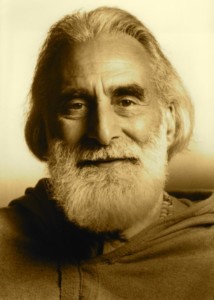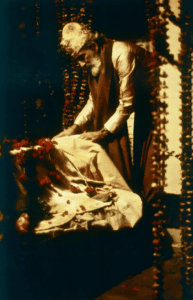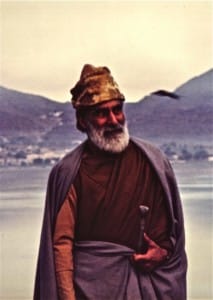 PIR VILAYAT INAYAT KHAN was born in London to Pirani Ameena Begum and Hazrat Inayat Khan on June 19th, 1916. From the age of six he was raised at Fazal Manzil in Suresnes, together with his elder sister Pirzadi Noor-un-nisa and younger siblings Murshidzade Hidayat and Murshidzadi Khair-un-nisa.
PIR VILAYAT INAYAT KHAN was born in London to Pirani Ameena Begum and Hazrat Inayat Khan on June 19th, 1916. From the age of six he was raised at Fazal Manzil in Suresnes, together with his elder sister Pirzadi Noor-un-nisa and younger siblings Murshidzade Hidayat and Murshidzadi Khair-un-nisa.
Life in Suresnes revolved around the riveting figure of Hazrat Inayat Khan. But in 1926, Murshid grew abstracted, and the family was seized with foreboding. On one occasion, Murshid gestured toward his shoes, telling his son, “You must follow in my footsteps.” Murshid left in September of that year. When the news came from India that Murshid had died, Ameena Begum was devastated, and never fully recovered.
Following their mother’s advice, Noor, Vilayat, Hidayat, and Khair-un-nisa (now known as Claire) studied music at the École Normale de Musique in Paris. Vilayat studied the cello with Maurice Eisenberg. In the summer lessons were held in San Vicente, Spain, where Vilayat had the privilege of listening to Pablo Casals practice at his seaside villa.
At the age of eighteen, reminded by Murshida Fazal Mai of his mandate from his father, Vilayat resolved to study philosophy. Commuting between Paris and Oxford, he studied Sufism with Louis Massignon and attended H. H. Price’s lectures on psychology.
In 1940 Europe was again at war. Ameena Begum, Noor, Vilayat, and Claire removed themselves to England. Ameena Begum and Claire served as nurses. Noor joined the WAAF and was recruited to the SOE, with heroic and tragic consequences. Vilayat joined the Royal Air Force and then the Royal Navy. As a mine sweeping officer, Vilayat (then known as Victor) served on a flotilla of motor launches that swept channels for landings on the coasts of France, Belgium, Holland, and Norway. These operations took place under heavy fire. Once Vilayat’s boat was capsized, and he only narrowly survived.
 Vilayat was heartbroken to discover the fate of his sister Noor, who was his dearest friend. In preparation for his future mission, Shaikh al-Mashaik Maheboob Khan wished to involve him in the work of the Sufi Movement, but his grief made him demure. He found solace in listening, every evening, to the whole of the B-Minor Mass of Bach on 78 rpm records.
Vilayat was heartbroken to discover the fate of his sister Noor, who was his dearest friend. In preparation for his future mission, Shaikh al-Mashaik Maheboob Khan wished to involve him in the work of the Sufi Movement, but his grief made him demure. He found solace in listening, every evening, to the whole of the B-Minor Mass of Bach on 78 rpm records.
Though desirous to resume his academic studies, as his mother was unwell and money was in short supply, he took employment at the India High Commissioner’s office in London, and later at the Pakistani Embassy, where he served for a time as Private Secretary to Ghulam Mohammed, the Finance Minister of Pakistan.
In 1949 Ameena Begum died, plunging Vilayat again into sadness. Meanwhile, his career was taking a new turn. He became a reporter for the Karachi-based newspaper Dawn, and was assigned to report on the Algerian independence movement. His articles exposing atrocities by the colonial regime drew the ire of the French government and made him, for a time, persona non grata in France.
Vilayat at last felt that the time had come to dedicate himself to his father’s legacy. He undertook contemplative retreats in such varied places as Montserrat, Mt. Athos, Jerusalem, Shiraz, Ajmer, and Gangotri. In Hyderabad, Sayyid Fakhruddin Jili-Kalimi guided him in the methods of the Chishti-Nizami-Kalimi lineage. On his emergence from a forty-day retreat, Pir Fakhruddin ordained him Pir, an appointment that was afterward confirmed in Ajmer by Diwan Saulat Husayn Chishti.
As the Sufi Movement had meanwhile taken its course without him, Pir Vilayat perceived the untimeliness of asserting his claim to succeed his father, and commenced his own organization, built on the foundation of Murshid’s original London constitution.
In the succeeding years Pir Vilayat traveled and lectured extensively, expanding the Order and establishing Sufi centers in several countries. In 1969 he met Murshid Samuel Lewis, who affiliated his circle with Pir Vilayat’s organization. The seventies were a time of spiritual and social experimentation, and the Sufi Order drew many young people from the counterculture. Pir Vilayat appreciated the idealism of the age, but was wary of its unbalanced excesses.
In 1975 the Order bought a complex of buildings in New Lebanon, New York, built in the eighteenth century by the Shaker Society. On this site the Abode of the Message was established. Pir Vilayat took up part-time residence there, along with some seventy-five Sufi initiates and their children. In addition to Sufi activities, the Abode hosted a farm, a bakery, and a school.
 Pir Vilayat led a life of constant travel, punctuated by solitary and group retreats. He kept a cave in the Alps of Chamonix, where the local people knew him as Le Vieux de la Montagne (“the Old Man of the Mountain”). Once during a retreat his cave was buried in snow, and angels visited him.
Pir Vilayat led a life of constant travel, punctuated by solitary and group retreats. He kept a cave in the Alps of Chamonix, where the local people knew him as Le Vieux de la Montagne (“the Old Man of the Mountain”). Once during a retreat his cave was buried in snow, and angels visited him.
It was Pir Vilayat’s contention that meditation was a science, and as such, it must continually advance. His own methodology, while grounded in the Sufi tradition of his father, was informed by Buddhism, yoga, and alchemy, and reinforced with insights from physics and biology.
In the course of his long life, Pir Vilayat initiated thousands of mureeds and spread his father’s Sufi Message far and wide. Despite many hardships, he radiated joy to the last. On June 17, 2004, he died in the Oriental Room of Fazal Manzil.
On hearing of Pir Vilayat’s passing, His Holiness the Dalai Lama wrote, “I have much admiration for him. His passing is a great loss, especially for those who not only follow the spiritual path, but also believe in tolerance for other religious traditions.”
